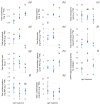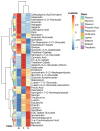Harnessing Light Wavelengths to Enrich Health-Promoting Molecules in Tomato Fruits
- PMID: 40565175
- PMCID: PMC12193516
- DOI: 10.3390/ijms26125712
Harnessing Light Wavelengths to Enrich Health-Promoting Molecules in Tomato Fruits
Abstract
The tomato (Solanum lycopersicum L.) is one of the most consumed crops worldwide and a source of antioxidants. Given the role the latter play against oxidative stress and free radical-related diseases, enhancing tomato bioactive compound production would be appealing for a wide range of applications in the fields of nutrition, pharmacy, and biotechnology. This study explores a sustainable and innovative approach: the modulation of specific light spectra to boost the production of bioactive compounds in tomatoes (cultivar 'Microtom'). We investigated how three light regimes-white fluorescent (FL), full-spectrum (FS), and red-blue (RB)-influence the accumulation of polyphenols and other key nutraceuticals during plant growth. Our findings reveal that full-spectrum (FS) light significantly enhances the levels of polyphenols, flavonoids, tannins, ascorbic acid, and lycopene in tomato fruits, compared to those grown under RB or FL light. Interestingly, fruits from RB light-grown plants showed the highest carotenoid concentrations and antioxidant capacity. These results suggest that light quality actively modulates the expression of key enzymes in the phenylpropanoid and flavonoid biosynthetic pathways, shaping each fruit's unique metabolic fingerprint. Cluster analysis confirmed that RB, FL, and FS conditions lead to distinct polyphenolic profiles, each with notable health-promoting potential. Our results highlight a promising avenue: tailoring light environments to enhance the functional value of crops, bridging agriculture, nutrition, and biomedicine in a sustainable way.
Keywords: antioxidants; biofortification; functional food; human health; light quality; phenolic compounds; tomato.
Conflict of interest statement
The authors declare no conflicts of interest.
Figures




Similar articles
-
Blue light regulates jasmonic acid synthesis via CRY1a and boosts antioxidant enzymes activity in Solanum lycopersicum to resist Botrytis cinerea.Plant Cell Rep. 2025 Jun 29;44(7):160. doi: 10.1007/s00299-025-03559-x. Plant Cell Rep. 2025. PMID: 40581909
-
Characterization of bioactive natural compounds and nutraceutical quality in Andean tomato landraces grown under optimal and elevated temperatures.J Sci Food Agric. 2025 Sep;105(12):6761-6772. doi: 10.1002/jsfa.14384. Epub 2025 May 22. J Sci Food Agric. 2025. PMID: 40401491
-
Visualizing the spatial distribution of metabolites in tomato fruit at different maturity stages by matrix-assisted laser desorption/ionization mass spectrometry imaging.Food Res Int. 2025 Apr;206:115973. doi: 10.1016/j.foodres.2025.115973. Epub 2025 Feb 21. Food Res Int. 2025. PMID: 40058890
-
[Meta-analysis on the role of lycopene in type 2 diabetes mellitus].Nutr Hosp. 2011 Nov-Dec;26(6):1236-41. doi: 10.1590/S0212-16112011000600007. Nutr Hosp. 2011. PMID: 22411366 Spanish.
-
Factors that influence parents' and informal caregivers' views and practices regarding routine childhood vaccination: a qualitative evidence synthesis.Cochrane Database Syst Rev. 2021 Oct 27;10(10):CD013265. doi: 10.1002/14651858.CD013265.pub2. Cochrane Database Syst Rev. 2021. PMID: 34706066 Free PMC article.
References
-
- Perveen R., Suleria H.A.R., Anjum F.M., Butt M.S., Pasha I., Ahmad S. Tomato (Solanum lycopersicum) Carotenoids and Lycopenes Chemistry; Metabolism, Absorption, Nutrition, and Allied Health Claims—A Comprehensive Review. Crit. Rev. Food Sci. Nut. 2015;55:919–929. doi: 10.1080/10408398.2012.657809. - DOI - PubMed
-
- Vitale E., Velikova V., Tsonev T., Ferrandino I., Capriello T., Arena C. The Interplay between Light Quality and Biostimulant Application Affects the Antioxidant Capacity and Photosynthetic Traits of Soybean (Glycine max L. Merrill) Plants. 2021;10:861. doi: 10.3390/plants10050861. - DOI - PMC - PubMed
MeSH terms
Substances
LinkOut - more resources
Full Text Sources

